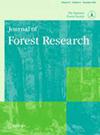Aquatic hyphomycete assemblages of Abies sachalinensis leaf litter immersed in a stream in Hokkaido, Japan
IF 1.1
4区 农林科学
Q3 FORESTRY
引用次数: 0
Abstract
ABSTRACTAquatic hyphomycetes are key decomposers of plant-litter in freshwater environments. Previous studies have shown that conifer needles are colonized less frequently by aquatic hyphomycetes than broad-leaf species. Sakhalin fir (Abies sachalinensis) is the most common coniferous tree species planted for timber production in Hokkaido, Japan. Herein, we investigated aquatic hyphomycete assemblages involving Sakhalin fir needle litter and compared them with those of broad-leaf tree species, including Japanese oak (Quercus crispula) and Japanese linden (Tilia japonica), during immersion in a stream. Seventy percent of the total fungal species observed in fir needles were also observed in broad-leaf litter. However, the structure of the aquatic hyphomycete assemblages differed between the fir and two broad-leaf species, especially in the middle to late stages of the immersion period. The increase in species number and conidia number in fir needles was slower than that in oak leaves in the early stages of the immersion period. However, they continued to increase rapidly relative to the broad-leaf tree litter during the middle stages of the immersion period. These results suggest that fir needle litter was not difficult for aquatic hyphomycetes to colonize in the middle to late stages of the immersion period.KEYWORDS: Aquatic fungiconifer litterSakhalin firfreshwaterfungal assemblage Disclosure statementNo potential conflict of interest was reported by the author(s).Supplementary materialSupplemental data for this article can be accessed online at https://doi.org/10.1080/13416979.2023.2265113Additional informationFundingThis work was supported by the Mitsui & Co., Ltd. Environment Fund, and JSPS KAKENHI Grant Number JP25252030.日本北海道溪流中浸没的冷杉凋落叶中的水生菌丝菌群
水生菌丝是淡水环境中植物凋落物的关键分解者。先前的研究表明,水生菌丝真菌在针叶树针叶上的定植频率低于阔叶物种。库页冷杉(Abies sachalinensis)是日本北海道最常见的针叶树种。在此,我们研究了库页冷杉针叶凋落物的水生菌丝菌组合,并将其与日本栎(Quercus crispula)和日本椴树(Tilia japonica)等阔叶树种浸泡在溪流中的水生菌丝菌组合进行了比较。在冷杉针叶中观察到的真菌种类中,有70%也在阔叶凋落物中观察到。然而,在杉木和两种阔叶树种之间,水生菌丝组合的结构存在差异,特别是在浸泡期的中后期。杉木针叶中物种数量和分生孢子数量的增加在浸水初期比栎树叶片缓慢。但在浸渍中期,相对于阔叶树凋落物,它们继续快速增加。上述结果表明,冷杉针叶凋落物在浸渍中后期对水生菌丝的定殖并不困难。关键词:水生真菌凋落物库页岛淡水真菌组合披露声明作者未报告潜在利益冲突。补充材料本文的补充数据可在https://doi.org/10.1080/13416979.2023.2265113Additional . info网站上获得。环境基金和JSPS KAKENHI基金资助编号JP25252030。
本文章由计算机程序翻译,如有差异,请以英文原文为准。
求助全文
约1分钟内获得全文
求助全文
来源期刊

Journal of Forest Research
农林科学-林学
CiteScore
3.00
自引率
6.70%
发文量
62
审稿时长
3 months
期刊介绍:
Journal of Forest Research publishes original articles, reviews, and short communications. It covers all aspects of forest research, both basic and applied, with the aim of encouraging international communication between scientists in different fields who share a common interest in forest science.
 求助内容:
求助内容: 应助结果提醒方式:
应助结果提醒方式:


